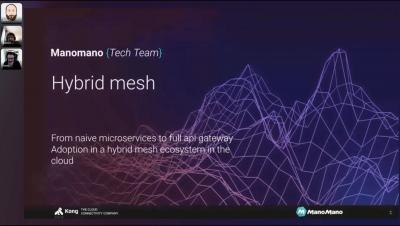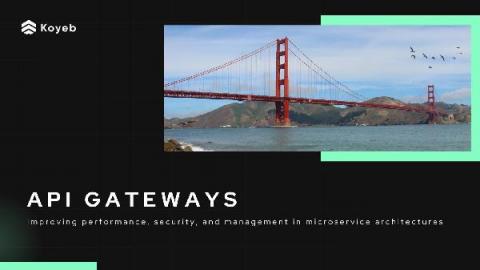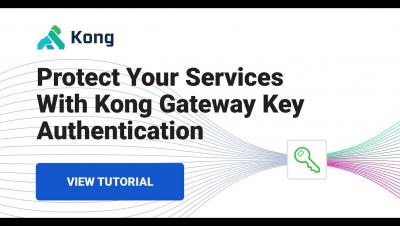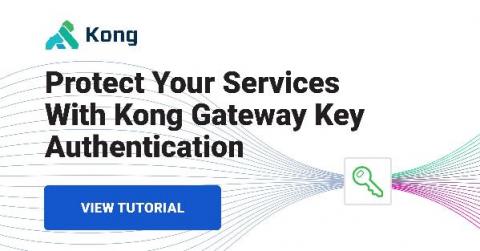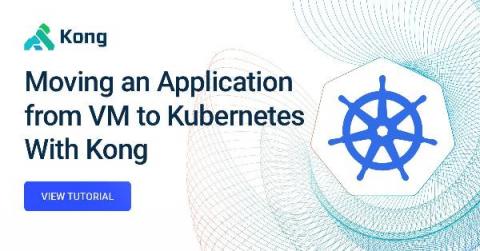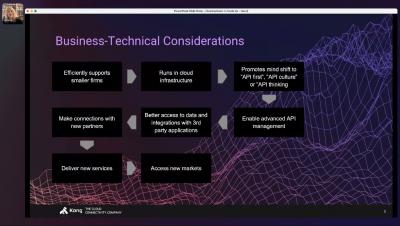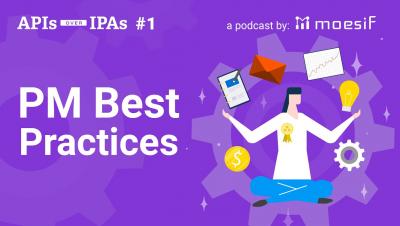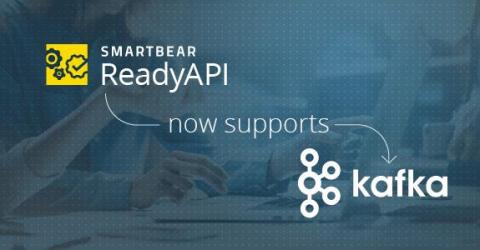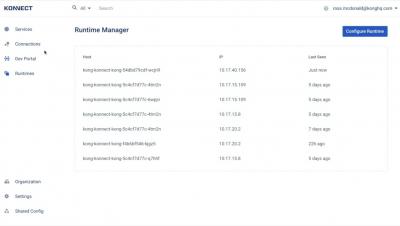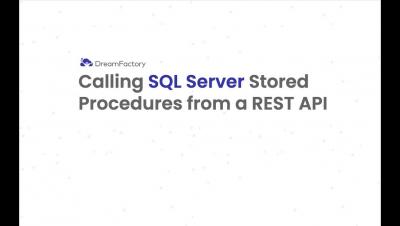Systems | Development | Analytics | API | Testing
May 2021
Kong Gateway OSS Turns Six!
🎂 Make a wish and blow out the candles…we’re celebrating Kong’s sixth anniversary! 👏👏👏 In 2015, Mashape open sourced Kong Gateway, launching the next generation of API management. In our last anniversary post, I took a look back at our history. For this 6th anniversary post, I’ll focus on how this year went and look forward to what’s coming up next.
America's Cybersecurity Mandate: 5 Ways to Adopt Zero-Trust Architecture
President Joe Biden issued an “Executive Order on Improving the Nation’s Cybersecurity” as of May 12, 2021. The order includes numerous actions and mandates to confront the dangers of cyber attacks that are increasing in frequency and sophistication. Cybersecurity has real and significant implications, both in economical and national security terms. At the time of this writing, the Colonial Pipeline cyber attack caused quite a stir on the USA’s east coast.
Okta and Kong Konnect Part 2: Applying Authorization Code Flow
decK 1.7.0 Released
If you’ve not heard of decK (our declarative configuration and drift detection tool for Kong Gateway) before, now’s a great time to get hands-on with it as we’ve just shipped decK v1.7.0 with a whole host of new goodies. Oh, and it’s all open source as usual.
Applying Authorization Code Flow With Kong and Okta
In our second Kong and Okta tutorial, we’ll go through the authorization code flow applied to user authentication processes. This series will show you how to implement service authentication and authorization for Kong Konnect and Okta using the OpenID Connect (OIDC) plugin.
API Gateways: Improving performance, security and management of microservices
As we've discussed in our previous Service Discovery post, decoupled services in a microservice architecture communicate via APIs. But what about the communication between clients outside of your system and the services within your application? How does that communication work? An API gateway is a powerful component in a microservice architecture. Pairing its functionality with a serverless platform like Koyeb saves engineering teams time and maximizes computing resources efficiency.
Securing Cloud Connectivity at Scale
Building a Kong Gateway Plugin with JavaScript
We recently sat down to discuss the language for the next Kong Gateway Plugin Development Kit (PDK). Given the number of JavaScript developers in the world and the variety of libraries and debugging tools available, there was only one logical choice. I’m excited to share that with the Kong Gateway (OSS) 2.4 release, that functionality is now available to you all!
Secure Proxy for HIPAA-Compliant API Analytics
In HeathTech apps, it’s often the case that you’re dealing with private or health-related data. This requires compliance with regulations, such as HIPAA in the United States. These regulations force you to handle sensitive data in a well-defined manner, so only specific people can read it, and if they do, it should be logged for later auditing.
The Mysterious Gotcha of gRPC Stream Performance
Here at Ably, we deal with hard engineering problems all the time and pushing at the edges often results in us running up against all sorts of interesting gotchas. We recently made some AWS NLBs fall over, and had a hazardous encounter with Cassandra counter columns. In our day-to-day, we use gRPC for fast and efficient data exchange with mutual client/server state synchronization.
Stripe APIs & DreamFactory
Shopify APIs & DreamFactory
How to Use the Kong Gateway Key Authentication Plugin
Protect Your Services With Kong Gateway Key Authentication
This tutorial will walk through a common use case for the Kong Gateway Key Authentication plugin: using API key authentication to protect a route to an API server endpoint. It’s a simple use case, but it will give you the foundation to deploy and configure the plugin for your own unique project needs. Before we walk through our mini-project, let’s cover a few core concepts.
Kong Konnect Enterprise & Elastic Container Service Anywhere (ECS-A)
One of the most powerful capabilities provided by Kong Konnect Enterprise is the support for Hybrid deployments. In other words, it implements distributed API Gateway Clusters with multiple instances running on several environments at the same time. Moreover, Kong Enterprise provides a new topology option, named Hybrid Mode, with a total separation of the Control Plane (CP) and Data Plane (DP).
Why Consolidating API Activities into an API Management Platform Could Benefit Your Organization
What are the Characteristics of an Effective API?
Typeform APIs & DreamFactory
Inside Zephyr - Johnatha Felix, Software Test Engineer for Zephyr Scale
Service Design Guidelines Part 2: API Versioning
We looked at service design considerations in the first part of this blog series. In this next part, I’d like to share some best practices for API versioning – a topic that comes up quite often with every customer as it is one of the key concerns when implementing API gateways. There are two ways to version RESTful APIs: URI and header-based, as summarized in this REST API tutorial.
Reasons why looking to a company's past can show their test innovation future
At SmartBear we have a vision for improving the lives of developers, and adding quality into the software development supply chain – no matter where in DevOps maturity an organization sits. We’ve seen a lot of success in this effort, and no small part of it involves the way we manage our acquisitions and invest in their development teams. This is true for software solutions like Zephyr, TestComplete, and ReadyAPI, as well as our innovators behind OSS projects, like Cucumber.
Simplifying API operations with AI as you scale your API programs
APIs are the backbone of digital transformation. Via APIs, you can securely share data and functionality with developers both inside and outside of your organizational boundaries, letting you build applications faster, seamlessly connect and interact with partners, and drive new business revenue. Because APIs encompass business-critical information, any downtime or performance degradation can lead to significant loss in revenue, customers, and brand value.
DreamFactory 4.7.0 Released!
Moving an Application from VM to Kubernetes
Containerization and orchestration are becoming increasingly popular. According to a recent survey conducted by Market Watch, the global container market will exceed $5 billion by 2026. In 2019, that number was under 1 billion. These statistics show that the world is moving more towards containers and orchestration faster and faster each day. One example of this is moving from VM to Kubernetes.
Achieving a Cloud-First Strategy with APIs
Scaling Down to Scale Up
Protecting Services With Kong Gateway Rate Limiting
The Kong Gateway Rate Limiting plugin is one of our most popular traffic control add-ons. You can configure the plugin with a policy for what constitutes “similar requests” (requests coming from the same IP address, for example), and you can set your limits (limit to 10 requests per minute, for example). This tutorial will walk through how simple it is to enable rate limiting in your Kong Gateway.
Kong Gateway 2.4 Now Generally Available!
Note to readers before we get started: you’ll see us referring to the “Kong Gateway” in this post. This is the product previously referred to as Kong Gateway Enterprise. In version 2.3, we released a free operating mode of Kong Gateway Enterprise, and given it no longer needs a paid “Enterprise” license, we now refer to this gateway as the Kong Gateway and disambiguate from the OSS-only Gateway as Kong Gateway (OSS).
APIs & Organizational Agility: Are You Getting the Benefits of API Adoption
APIs: Turning Businesses into Platforms
How Organizations Add Value with APIs
Inside Zephyr - Govind Drolia, the Product Owner of Zephyr Enterprise
API design 101: Links to our most popular posts
APIs play a critical role in helping software connect and communicate, as well as making the lives of developers a little easier. Over the years we’ve published a number of posts to help developers design APIs to get the most from them. Below is a list of our most popular API design posts you can read now or bookmark for later.
How DueDil leverages Apigee API-first approach to deliver data insights at scale
As their name reflects, DueDil provides due diligence services ranging from customer-specific risk evaluations and selections to customer onboarding and real-time risk monitoring for leading financial services, high-growth tech and insurance companies. Founded in 2009, the company helps more than 3,000 enterprise users from over 400 clients to not only understand with whom they’re doing business, but to do so with increased efficiency and in compliance with regulatory requirements.
Getting Started With Kong Konnect in 10 Minutes
In this Kong Konnect tutorial, you’ll learn how to leverage the platform to manage your API ecosystem from a single easy-to-use interface.
Scaling Service Mesh Across Clouds
Implementing Client Credentials With Kong and Okta
Using Kong’s OpenID Connect (OIDC) plugin, Kong and Okta work together to solve three significant application development challenges: The OIDC plugin enables Kong, as the API gateway, to communicate with Okta via the OAuth/OIDC flows. That way, your app teams don’t have to configure and diagnose authentication and authorization for each service individually. With these challenges solved, app teams have more time to build and innovate.
Why Your Engineers Want to Migrate to Kubernetes
Software teams have found themselves in the center of the business’ strategy. Their strategic decisions on technologies to invest in has resulted in greater agility and the ability to build products that differentiate their companies in the market. As a result, optimizing the ability for software teams to deliver by investing in stronger tooling has become a core priority.
Kong Konnect Plus: Accessible Connectivity for All
Today, we are thrilled to announce that we have expanded open access to Kong Konnect, the world’s only cloud native, full lifecycle service connectivity platform, for everybody anywhere in the world, thanks to a new plan called Konnect Plus! Available today with a free 30-day trial.
APIs: The Key to IT Decentralization
APIs and IoT: Generating Increased Connectivity for Your Organization
The New Getting Started with Dreamfactory Guide Has Launched!
The maturity of public transport APIs 2019
Ep #1: Deserve's Jeremy Glassenberg on Best Practices for API Product Managers
Succeeding in the digital economy
Konnect decK: Automating Your Developer Pipeline
APIOps for Standardization Without Hindrance (Destination: Scale)
Introducing Apache Kafka & Event-Driven Architecture Support in ReadyAPI
In 2006, SoapUI was developed with a singular goal: create a simple, open-source SOAP API testing tool. Since then, developers have contributed code and provided valuable feedback to help SmartBear transform SoapUI into ReadyAPI, the most powerful API testing platform on the market.
SmartBear Adds Testing Support for Popular Event Streaming Platform Apache Kafka
ThoughtSpot Everywhere - Build Interactive Data Apps
Kong Konnect: Maximize Service Reuse, Observability and Manageability
Kong Configurations Using Terraform via GitOps Model
As organizations adopt a microservices architecture, API gateway usage has increased. Kong Gateway is one of the promising API gateways in the market. It has both OSS and enterprise support, releases multiple features and is easy to use. Kong Admin API helps administrators configure the system easily, but it’s still error-prone. That’s because the user has to hit many curl calls for creating all the configs. When numerous folks are managing the system, this becomes difficult.
Out with GraphQL, in with gRPC
At Speedscale, we’re always trying to find ways to iterate faster and reduce developer toil. In line with that mission, we slant our engineering decisions towards using cutting edge tech because we usually move faster and it also allows us to help our customers later on when they upgrade their own tech stack. Recently, we had the opportunity to upgrade the communication channel between our api-gateway and react front end. This journey provided some unexpected benefits.
Why Your Organization Needs to Embrace APIs
What is the API Economy?
Improving Customer Experience with APIs
Getting Started with Kong Konnect in 10 Minutes
Calling SQL Server Stored Procedures from a REST API
Why Upgrade Your WSO2 Enterprise Integrator?
Today, connecting various heterogeneous systems (or protocols) is key when developing complex integration solutions. Also, due to the wide range of deployment environments (i.e., on-premises, cloud, and container-based), this process becomes even more difficult.


